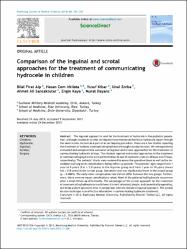| dc.contributor.author | Alp, Bilal Fırat | |
| dc.contributor.author | Irkilata, Hasan Cem | |
| dc.contributor.author | Kibar, Yusuf | |
| dc.contributor.author | Zorba, Ünal | |
| dc.contributor.author | Sancaktutar, Ahmet Ali | |
| dc.contributor.author | Kaya, Engin | |
| dc.contributor.author | Dayanç, Murat | |
| dc.date.accessioned | 2020-12-19T20:15:54Z | |
| dc.date.available | 2020-12-19T20:15:54Z | |
| dc.date.issued | 2014 | |
| dc.identifier.citation | Alp, B.F., Irkilata, H.C., Kibar, Y., Zorba, U., Sancaktutar, A.A., Kaya, E., Dayanc, M., (2014). Comparison of the inguinal and scrotal approaches for the treatment of communicating hydrocele in children. Kaohsiung Journal of Medical Sciences, 30(4), 200-205.https://doi.org/10.1016/j.kjms.2013.11.006 | |
| dc.identifier.issn | 1607-551X | |
| dc.identifier.uri | https://doi.org/10.1016/j.kjms.2013.11.006 | |
| dc.identifier.uri | https://hdl.handle.net/11436/4067 | |
| dc.description | PubMed: 24656161 | en_US |
| dc.description.abstract | The inguinal approach is used for the treatment of hydrocele in the pediatric population. Although studies on scrotal orchiopexy have mentioned hernia or hydrocele repair through the same scrotal incision as a part of an orchiopexy procedure, there are a few studies reporting the treatment of isolated communicating hydrocele through a scrotal incision. We retrospectively evaluated and compared the outcomes of inguinal and scrotal approaches for the treatment of communicating hydrocele in boys. The classical inguinal and scrotal approaches to the treatment of communicating hydrocele were performed on 46 and 30 testicular units (in 43 boys and 27 boys, respectively). The patients' charts were reviewed to assess the operative times as well as the immediate and long-term complications during follow-up periods. The patients' ages ranged from 1 year to 8 years (3.6 ± 2.0 years) in the inguinal group and from 1 year to 10 years (mean 4.6 ± 2.8 years) in the scrotal group. Operative time was significantly lower in the scrotal group (p < 0.0001). The early minor complication rate did not differ between the two groups. Furthermore, there were no major complications noted. None of the patients had hydrocele recurrence after a mean follow-up of 6 months. The advantages of the scrotal approach for the treatment of communicating hydrocele are as follows: it is well tolerated, simple, and cosmetically appealing, and it has a short operative time in comparison with the standard inguinal approach. The scrotal incision technique is an effective alternative in communicating hydrocele treatment. © 2013, Kaohsiung Medical University. Published by Elsevier Taiwan LLC. All rights reserved. | en_US |
| dc.language.iso | eng | en_US |
| dc.publisher | Elsevier (Singapore) Pte Ltd | en_US |
| dc.rights | info:eu-repo/semantics/openAccess | en_US |
| dc.subject | Children | en_US |
| dc.subject | Hydrocele | en_US |
| dc.subject | Inguinal | en_US |
| dc.subject | Scrotal | en_US |
| dc.subject | Surgery | en_US |
| dc.title | Comparison of the inguinal and scrotal approaches for the treatment of communicating hydrocele in children | en_US |
| dc.type | article | en_US |
| dc.contributor.department | RTEÜ, Tıp Fakültesi, Cerrahi Tıp Bilimleri Bölümü | en_US |
| dc.contributor.institutionauthor | Zorba, Ünal | |
| dc.identifier.doi | 10.1016/j.kjms.2013.11.006 | |
| dc.identifier.volume | 30 | en_US |
| dc.identifier.issue | 4 | en_US |
| dc.identifier.startpage | 200 | en_US |
| dc.identifier.endpage | 205 | en_US |
| dc.relation.journal | Kaohsiung Journal of Medical Sciences | en_US |
| dc.relation.publicationcategory | Makale - Uluslararası Hakemli Dergi - Kurum Öğretim Elemanı | en_US |


















